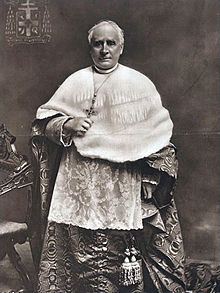See New York Appointed September 15, 1902 | Term ended September 17, 1918 Ordination June 11, 1870 Name John Farley | |
 | ||
Died September 17, 1918, Mamaroneck Education St Macartan's College, Pontifical North American College | ||
John Murphy Farley (April 20, 1842 – September 17, 1918) was an Irish-born prelate of the Roman Catholic Church. He served as Archbishop of New York from 1902 until his death in 1918, and created a cardinal in 1911.
Contents

Early life and education
John Farley was born in Newtownhamilton, County Armagh, Ireland, to Philip and Catherine (née Murphy) Farley. At age 7, he was orphaned following the death of both his parents. He received his early education under the direction of a private tutor named Hugh McGuire. He then attended St. Macartan's College in Monaghan from 1859 to 1864.
Under the auspices of an uncle, Farley emigrated to the United States at the height of the Civil War in 1864. He immediately enrolled at St. John's College in New York City, graduating in 1865. He then began his studies for the priesthood at St. Joseph's Provincial Seminary in Troy. In 1866, he was sent to continue his studies at the Pontifical North American College in Rome. He was present in Rome during the whole period of the First Vatican Council.
Priesthood
Farley was ordained a priest by Cardinal Costantino Patrizi Naro on June 11, 1870. His first assignment, following his return to New York, was as a curate at St. Peter's Church in New Brighton, Staten Island, where he remained for two years. Following the appointment of Francis McNeirny to the Diocese of Albany, Farley became secretary to Archbishop John McCloskey in 1872. He accompanied McCloskey to the 1878 papal conclave, but they arrived after the election of Pope Leo XIII had already taken place.
From 1884 to 1902, Farley served as pastor of St. Gabriel's Church in Manhattan. During his tenure at St. Gabriel's, he freed the parish from debt, oversaw the consecration of the church, built a parish hall, and instituted parochial visitation by the clergy. He was named a papal chamberlain in 1884, and raised to the rank of domestic prelate in 1892. In addition to his pastoral duties at St. Gabriel's, Farley served as vicar general for the Archdiocese of New York from 1891 to 1902. He also served as president of the Catholic school board, in which position he organized a Catholic school parade in 1892. He later organized a Catholic school exhibit in 1894. He became a protonotary apostolic in 1895.
Episcopal career
On November 18, 1895, Farley was appointed auxiliary bishop of New York and titular bishop of Zeugma in Syria by Leo XIII. He received his episcopal consecration on the following December 21 from Archbishop Michael Corrigan, with Bishops Charles Edward McDonnell and Henry Gabriels serving as co-consecrators, at St. Patrick's Cathedral. Farley became Apostolic Administrator of the archdiocese upon the death of Archbishop Corrigan on May 5, 1902, and was himself named the fourth Archbishop of New York on September 15 of that year. He was honored as an Assistant at the Pontifical Throne in 1905.
Pope Pius X created him Cardinal Priest of Santa Maria sopra Minerva in the consistory of November 27, 1911. He was one of the cardinal electors who participated in the 1914 papal conclave, which selected Pope Benedict XV. Following the outbreak of World War I, Farley stated, "I would that peace could come by arbitration and diplomacy. It seems, however, that no permanent peace can be hoped for except through the defeat of German arms in the field or the repudiation of the Prussian autocracy by the German people themselves. Criticism of the government irritates me. I would consider it treason." He also said, "As Catholics in America, we owe unswerving allegiance to the Government of the United States, and it is our sacred duty to answer with alacrity every demand our country makes upon our loyalty and devotion." His dedication to victory in the war angered the Sinn Féin element of the New York clergy, who believed the Cardinal was bowing to anti-Irish bigots.
He made progress in Catholic education in the archdiocese the keynote of his tenure as Archbishop, and established nearly fifty new parochial schools within his first eight years; he also founded the Cathedral Preparatory Seminary. He was known to take daily walks with one of his priests down Madison or Fifth Avenue, noting, "A man never collects his thoughts so well as when he walks alone or with a congenial spirit."
Farley died in Mamaroneck, at age 76. He is buried in the crypt under the altar of St. Patrick's Cathedral.
